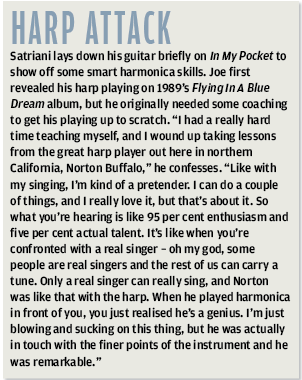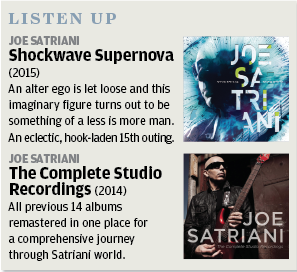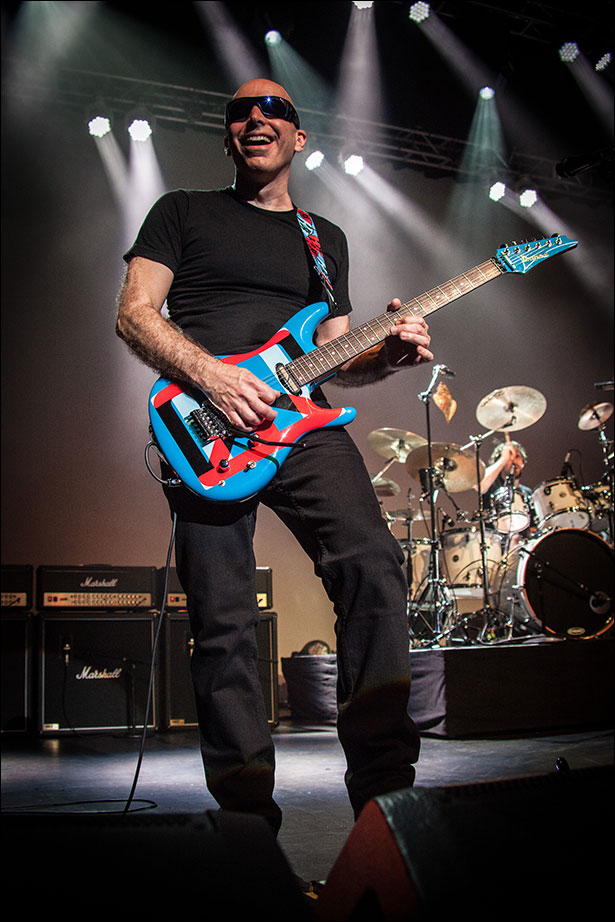Interview: Joe Satriani talks Shockwave Supernova
Just who in the world would be mad enough to play instrumental rock guitar music in this day and age? Joe Satriani tells Steve Bailey all about the flamboyant alter ego he created to help him wrestle with a question that’s close to his heart…

The year 2014 was something of a milestone for Joe Satriani. Both his career-spanning boxset The Complete Studio Recordings and his autobiography Strange Beautiful Music were unleashed on the public, which meant he’d spent a lengthy period painstakingly examining the events and musical evolution that had brought him to this point in his existence.
This work-imposed philosophical navel-gazing process would appear to have helped spawn a brand new guitar hero, albeit an imaginary one. Satriani’s outrageous, Ziggy Stardust-style alter ego – Shockwave Supernova – is an anarchic character, who looks very much like Satriani and sounds very much like Satriani, but, it would appear, is willing to take ideas and concepts to an extreme that plain old Joe may have balked at.
“It’s very difficult to explain,” he concedes. “The record was formed by this conceptual device. The music represents the memories, the aspirations, the problems, the troubles, the agony and ecstasy of this character who happens to be an instrumental rock guitarist.”
It was in Singapore, playing the last show of the 2014 Unstoppable Momentum tour when Satriani became aware that his stage antics were becoming somewhat exaggerated.
“My front teeth were feeling kinda funny, and I realised that I had been playing with my teeth more than ever before,” he remembers. “I kept saying to myself, walking out on stage, ‘Now Joe, don’t play with your teeth tonight, it’s totally crass and you just shouldn’t do it’. Of course, there I was playing with my teeth again and meanwhile going, ‘What is it that’s making me do that?’.”
Satriani began to formulate a plan that he felt might release a fresh burst of creative energy. “I’ve never really done a concept kind of a record before,” he says. “I thought, ‘Who is this guy who is crazy enough to play instrumental rock guitar music in a world dominated by hip-hop and pop? What would he call himself?’ So this name popped into my head. He’s someone who walks into a room and says, ‘Hey everybody, it’s Shockwave Supernova!’ The kind of person you roll your eyes at and go, ‘Oh no, who invited him?’.”

At first, Satriani wasn’t going to share the concept with the wider public, instead using it simply as a songwriting tool.
“It was a personal joke, because I’m a kind of shy retiring type,” he explains, “but when you’ve got thousands of people looking at you, you can’t just be ordinary. You’ve gotta pull that person out of you from time to time. I’ve learned to love this Shockwave Supernova character and its been quite a journey to pull things out of his psyche, out of his soul, and write songs about it.”
It may be a curious technique, but it has produced arguably Satriani’s most accessible and hook-laden album to date.
“My experience over all these decades of working on instrumental guitar music is you really have to understand restraint,” he says. “Every second of the day, you have to say, ‘Is this a real melody or am I just throwing my fingers around?’. I don’t mind kicking back and playing a lot less if it means creating a memorable musical moment that’s unique to a song’s particular story. I do think this device helps me with that.”
Satriani found that the cathartic nature of going through the process of writing the book and remastering his back catalogue meant that he was digging deep into his memory, and that also sparked his muse.
“You’re looking at pictures that you keep way back in the drawer, you know?” he recalls. “‘Yes, I did wear that. Oh my god!’ It left me in this vulnerable state. I was off at home for a couple of months and I caught the H1N1 virus. It’s the kind of flu you never want to get. I couldn’t do much but just sit down and play guitar, which I did all day long. Out of that period came a lot of reflective music.”

This is your life
The inspiration for the album hadn’t yet hit Satriani by that point. It was to be another year of touring before everything came together, but much of that music was adapted to fit the peculiar narrative of Shockwave Supernova’s life.
“I doubt anyone will ever approach me to bring it to Broadway!” he admits. “We do take liberties; theres one song, There’s No Heaven, that has such an 80s vibe to it. The idea is Shockwave is thinking about who he was in the 80s and what he did. The device gave us artistic licence to say we can have a song that does that.
“Marco gave such an 80s drum attitude to it, I wound up using my vintage Roland JC120 on the rhythm guitars, and we just had fun with it. We had mixes where we really went nuts, well beyond the likes of The Cure in terms of how much you can chorus the guitar!”
The opening track, Shockwave Supernova, announces the arrival of our hero, and is a multi-guitar opening salvo. Almost the entire track is driven by slide, something that has crept more and more into Joe’s work. In unorthodox fashion, much of the bottleneck was done on a pair of 12-strings.
“That track has the largest amount of guitars on it,” Joe explains. “John Cuniberti [Satriani’s long-term producer] cleverly figured out how to put them all together and how to get it to work. Using 12-string as the main instrument is slightly different for me, I’m not quite sure I’ve ever done it. I think that probably Chickenfoot saw me using the 12-string as more of an out-front instrument.
“I’ve got an Ibanez double-neck that my back will not allow me to even wear! It was always on a stand, Sammy Hagar never let me forget how uncool it was that it was on a stand. So I’ve done a lot of slide work, unusual tunings, just using harmonics, but it was mostly just in the background.
“I was going to be clever with the bar. John was like, ‘No, I want to hear slide!’ So he forced me into it. We basically got 90 per cent through the whole thing with slide, and he would go ‘OK, the thing just doesn’t sound good at that note, that register on those strings, so we would swap guitars. The slide playing is split between a Korean-made Epiphone Les Paul 12-string, a vintage Candy Apple Red Fender Electric XII and a regular six-string Ibanez.
“We basically constructed the track so it’s constantly switching between guitars; it could be only two fretted notes, and then it could go back to slide. It was mainly just because the instruments that we wanted to use were not in such good shape, so we had to get very clever with how we recorded it.”
Another piece of kit that has become more prevalent in Satriani’s work is the Sustainiac pickup, and it’s used to its full potential on this record.
“There are pieces of music on there where the melody was able to be a bit more expressive because I was using the Sustainiac,” says Satriani. “It allows you to bring your volume down, and yet to have this unusual sort of sustain. The song Butterfly Zebra is a perfect example.
“My guitar’s volume is actually on around four, but with the Sustainiac the notes are like droplets of water that you see forming and then take a long time to finally drop down. They have this quality about them that is quite unique.”
Satriani first realised the potential of the Sustainiac when he saw Robert Fripp using it, but didn’t opt to try one himself until around the time of his Black Swans And Wormhole Wizards album. “You know how guitar players are, you see somebody play into a pedal that you like and you go, ‘I gotta get me one of those!’ he laughs. “But then I thought, ‘hold on a second, that’s Robert’s trick’.
“Then my good friend Neal Schon put them in his guitars, but Neal’s approach was different, it was seamless. He didn’t want to remind the audience that he was using it, he was just providing this beautifully sustained guitar. Then Steve Vai started to use them and, of course, we tour together all the time, so I’d watch him play his.
“He would use it both for melody and also for very theatrical moments where he’d be playing with his tongue or manipulating it some other way. I thought, ‘OK Joe, if you buy one of those don’t do any of that!’ I found some unique ways of using it. It’s sort of like a talkbox. If you buy one of those, the first thing that you think about is Peter Frampton, and then there’s Bon Jovi and there’s Joe Walsh. If you’re gonna do it, you’d better do something different.”
Satriani points out that there are two different types of these pickups currently on the market, the Sustainer – made by the Japanese company Fernandes – and the US-manufactured Sustainiac. Satriani opted to use the Sustainiac, because it gives him the ability – via the onboard toggle switch – to access three different octaves.
“Ibanez does not actually make a model with a Sustainiac yet, but it does seem to pair really well with my Ibanez guitars,” explains Satriani. “I’m going between those switches all the time. I wound up putting them in all my touring guitars because it allowed us to have that flexibility of changing a setlist night after night.”

Take it to the bridge
Satch has also developed a bit of a thing for EverTune bridges, which supply near-perfect intonation, as he explains: “I have about six various Ibanez prototypes with EverTunes installed on them. They come in handy now and then. You take one and you stick it in the stereo field somewhere, balance it against the other.
“They’re great if you’re trying to match the intonation of a keyboard or some other kind of instrument that has a perfect kind of intonation scheme. Although I have to say I don’t mind the quirky nature of a regular guitar’s intonation. The pushing and the pulling of intonation is sometimes what makes things exciting to listen to.
“It’s the same as if you correct all the timing, you can just work the life out of something. We call it the intonation highway, and it’s nice to have a really big one – several lanes rather than just a single road with no variation. There’s no fun there.”
Perhaps the most bombastic solo work on Shockwave Supernova appears on the track On Peregrine Wings, where Satriani was able to really let loose and put aside any notions of what people expect to hear from a Joe Satriani album.
“I was working on the solo section of the song, and initially I felt it should be very complex, but then I did the strangest thing,” says Satriani. “I thought, ‘What if it just became totally bonehead, and there was just this one bass note, just chugged?’ So, reacting to the sound of a Marshall turned all the way up, I played a solo which I thought was very non-technical. It will probably anger some prog-heads.
“They will say, ‘Hey! He’s not picking every note’. If you don’t play like you practise, some guitar players don’t like it. Well fuck that! This is about a guy who’s wearing alien wings for the first time and he’s flying off the edge of a precipice; who cares about picking notes? I just wound up improvising this solo at home. When we got to the studio, John Cuniberti was like, ‘I love that solo! It’s so weird, it’s like you start playing, and then hang onto this one note’.”
Never fear, though, Satriani hasn’t completely abandoned his esteemed cerebral musical philosophy and adopted a totally minimalist approach. Even within that same song, there are complex, structured ensemble parts, too. It’s just that his new imaginary songwriting partner has finally freed him up from certain constraints.
“It’s about going with the story of the song and not about Joe Satriani, professional guitarist,” Joe insists. “The idea is that by the time the song ends, hopefully you’re exhaling and you’re going, ‘Oh man, what a wild ride that was’. I want to spark some kind of imagination in people, so they can relate their own story to it. I don’t want people always thinking, ‘Is he playing enough notes?’, or ‘Is he picking upstrokes or downstrokes?’ If you get stuck on it, that stuff will drive you mad, eventually.”


